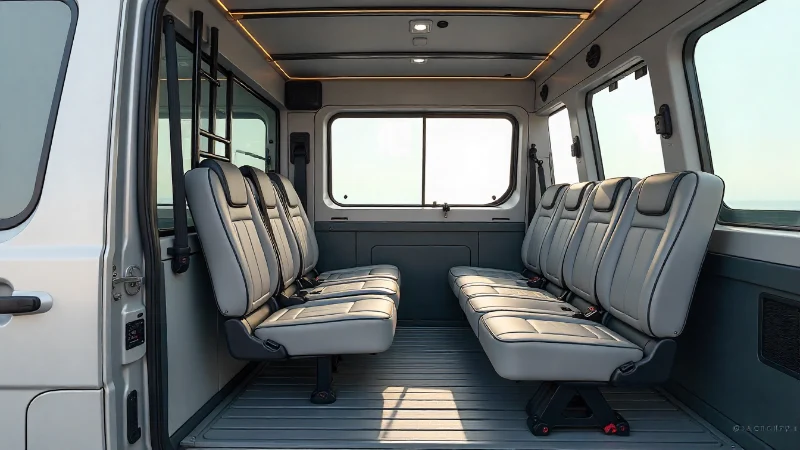How to Transport a Ladder Without a Roof Rack: Your Ultimate Guide
You’ve got the ladder, you’ve got the car, but there’s one crucial piece missing: a roof rack. This common scenario can leave you feeling stuck, wondering how to get your essential tool from point A to point B safely and legally. The good news is that you don’t always need expensive, specialized equipment.
Transporting a ladder without a roof rack is entirely possible with the right techniques. This guide will walk you through several secure methods, ensuring the safety of your vehicle, your ladder, and everyone else on the road. We’ll cover everything from using your car’s interior to safely managing overhang from your trunk.
You'll Learn About
Why Proper Ladder Transportation is Non-Negotiable
Improperly secured ladders pose a significant risk. An unsecured ladder can shift during transit, causing costly damage to your vehicle’s paint, windows, or body. Even worse, it could fall onto the road, creating a serious hazard for other drivers and potentially leading to accidents and legal liability.
Understanding and adhering to local laws regarding load overhang is also critical. Many regions have specific rules about how far an object can protrude from your vehicle and require warning flags for visibility. Following these guidelines is not just about avoiding fines; it’s about ensuring public safety.
The Risks of an Unsecured Ladder
The dangers of a poorly transported ladder cannot be overstated. A sudden stop or sharp turn can send a loose ladder flying, endangering pedestrians and other vehicles. The potential for causing a serious accident makes it imperative to use a reliable method to secure your load every single time.
Beyond the immediate safety risks, consider the damage to your equipment. Ladders are an investment, and allowing one to slide around unprotected can lead to bent rungs, damaged rails, and a shorter lifespan for your tool. Taking a few extra minutes to secure it properly protects your investment.
Method 1: Transporting the Ladder Inside Your Vehicle
The safest and simplest way to transport a smaller ladder is inside your vehicle. This method completely eliminates concerns about weather, road debris, and aerodynamic drag. It’s an ideal solution for A-frame ladders, step stools, and shorter extension ladders.
Before attempting this, measure your ladder and your vehicle’s interior space. Many compact cars and SUVs have fold-down rear seats that create enough room for ladders up to 8 feet long. This internal storage protects your ladder from theft and keeps it clean during transit.
Step-by-Step Guide for Internal Transport
First, prepare your vehicle by clearing out the trunk and folding down the necessary seats. To protect your car’s interior from scratches and dirt, lay down a thick blanket, tarp, or moving pad. This simple step can save your upholstery from unnecessary wear and tear.
Next, carefully slide the ladder into the vehicle. Position the front passenger seat forward and recline it as much as possible to create a flat, continuous space. Once the ladder is inside, use bungee cords or ratchet straps to secure it to anchor points in your car, preventing it from shifting while you drive.

Method 2: Using Your Trunk or Pickup Bed
For ladders that are too long to fit inside your car, the trunk can be a viable option, provided you take the proper precautions. This method is often suitable for extension ladders that, when collapsed, are only slightly longer than your vehicle’s interior space. Similarly, a pickup truck bed is designed for hauling bulky items.
The key to this method is securely fastening the ladder and flagging any overhang. Never simply let the ladder rest in the open trunk or truck bed unsecured. The movement from driving can easily cause it to slide out, creating a dangerous situation.
Securing a Ladder in a Sedan’s Trunk
Start by laying down protective padding on the edge of your trunk to prevent paint damage. Slide the ladder in at an angle, letting it rest over the folded-down back seats and extending toward the front of the car. It’s important that the ladder does not obstruct your view or interfere with your ability to operate the vehicle safely.
Use strong ratchet straps to anchor the ladder. One effective technique is to run the straps through the rungs and secure them to solid points on your car’s undercarriage or through the rear windows. Tie the trunk lid down securely against the ladder to minimize bouncing, but use padding to avoid pressure damage.
Securing a Ladder in a Pickup Truck Bed
Transporting a ladder in a pickup truck is more straightforward. For shorter ladders, lay them flat in the bed and use tie-down points to secure them with ratchet straps. For longer extension ladders, you can place the base against the front of the bed and let the other end rest on the closed tailgate.
If the ladder extends beyond the tailgate, it’s crucial to use a bright red or orange flag to alert other drivers. Federal regulations in the U.S. generally require a flag for any rear overhang of four feet or more, but it’s wise to check your local laws. In some cases, such as dealing with unexpected home repairs like finding out which breaker is my smoke detector, a quick and secure transport method is essential.
Method 3: A DIY Temporary Roof Solution
If neither of the previous methods works for your situation, you can create a temporary, padded setup directly on your car’s roof. This approach requires careful attention to detail to avoid damaging your vehicle’s roof and to ensure the ladder is completely secure. It is best suited for shorter, lighter ladders.
Use high-density foam blocks, pool noodles, or thick, folded blankets as a buffer between the ladder and the roof. This padding will distribute the weight and prevent scratches and dents. Place the padding at the front and rear of the roof for stable support.
How to Safely Strap the Ladder to the Roof
Center the ladder on the padding. Open all your car doors and run ratchet straps over the top of the ladder and through the inside of the car. Run at least two straps over the ladder, one near the front and one near the back, and tighten them inside the vehicle.
Ensure the straps are not positioned where they could interfere with your head or the deployment of airbags. Give the ladder a firm shake from all sides to test its stability. If there is any movement, you need to tighten the straps or reposition the ladder. Proper securing is vital, much like when you need to know how to stop a leaking pipe with water in it; a small mistake can lead to big problems.
Legal and Safety Checklist
Before you hit the road, it’s crucial to be aware of the legal requirements and safety best practices. Laws regarding overhanging loads vary by state and country, so a quick search for your local regulations is always a good idea. Safety should always be your top priority.
Always double-check your work. Before you start driving, give the ladder a thorough test to ensure it is immobile. Pull and push on it from various angles. After driving a short distance, pull over in a safe location and check the straps again to make sure nothing has loosened.
Understanding Overhang Laws
In the United States, Department of Transportation (DOT) regulations provide a general guideline. Typically, an object cannot extend more than 3 feet in front of the vehicle or 4 feet from the rear without being marked. A red or orange flag, at least 18 inches square, must be attached to the end of any protruding load.
For nighttime transport, a red light is often required at the extreme end of the load. Failing to comply with these rules can result in fines and is a significant safety hazard. These regulations are in place to protect everyone on the road.
| Transport Method | Pros | Cons | Best For |
|---|---|---|---|
| Inside Vehicle | Most secure, protects ladder from elements. | Limited by vehicle size, can damage interior. | Step ladders, small extension ladders (up to 8 ft). |
| Trunk/Truck Bed | Good for longer ladders, relatively simple. | Requires proper flagging, potential for paint damage. | Extension ladders (10-16 ft), pickup truck owners. |
| DIY Roof Setup | Versatile for cars without racks. | Risk of vehicle damage if not padded, less secure. | Lightweight ladders, short distances. |
When to Consider Alternatives
Sometimes, the safest and most practical solution is to not use your own vehicle. If you need to transport a very long or heavy ladder, such as a 40-foot extension ladder, the risks associated with securing it to a standard passenger car may outweigh the convenience. The complexities of such a task can be compared to troubleshooting advanced technical systems, like identifying cascade refrigeration system problems with solutions; sometimes, you need specialized equipment.
In these cases, consider renting a pickup truck or a trailer from a local hardware or rental store. The cost is often minimal and provides a much safer and purpose-built solution for the job. This option eliminates overhang issues and the risk of damaging your car.
Final Thoughts on Ladder Transportation
Transporting a ladder without a roof rack is a common challenge, but it is one that can be overcome safely with the right knowledge and preparation. By choosing the appropriate method for your specific ladder and vehicle, using high-quality securing straps, and adhering to all safety and legal guidelines, you can ensure your ladder arrives at its destination without incident.
Always prioritize safety above all else. A few extra minutes spent securing your ladder properly can prevent costly damages and, more importantly, a dangerous accident. Drive cautiously, check your load periodically, and you’ll be able to tackle any project that comes your way.

